Egg Chamber

Egg Chamber
In some environments, it's hard to tell the difference between genders and species. Organisms share genetic material more easily on this planet, and that leads to some complicated taxonomy. In this case, we see a group of aquatic creatures acting as nurses for a seemingly endless field of eggs. But the network of underwater chambers in which they reside is in fact another living creature. By some categorizations, it would be considered the female of the species - it produces and to some extent nourishes the field of eggs, some of which mature to be gigantic network-chambers themselves. Whether this is an extreme example of sexual dimorphism, or the result of some sort of horizontal gene transfer is a matter of conjecture at this point.
More Posts from Exobiotica and Others

A new environment with some new species here.
This is the first look into this particular biome- hopefully with more to come. All creatures depicted have a photosynthetic component to them - least of all the large plodding walkers, who rely most heavily on grazing for their energy intake. The creatures that resemble flowers are motile, but move less frequently. The long rope-like organism grows at a rapid pace to stake its claim over as much ground area as possible. The large round textures semi-spheres are not phased by this tactic, as they employ an electro-chemical defense over their outer surface to keep the strident ropes at bay.



Pelagic predator pen sketch. More on this soon.





Full of Stars
The season's storms had taken their toll, opening up an organic cave in the otherwise sealed mountain canopy forest. Encouraged by the prospect of shelter from more incoming inclement weather, the dacia considers entering the dark, yet inviting refuge. The glittering biolights beckon, but this new environment is far stranger than anything it’s ever known.




Tripodal Plains Runner
An agile and fast herd-dwelling inhabitor of the open plains, this creature posesses no true jointed appendages. Its legs and periscope are comprised of rigid, yet flexible hydraulic tubes. Sensory organs are clustered on the top of its upward-pointing appendage to give maximum perspective even during more vulnerable moments like feeding.

A common site in these dry rocky areas is the Velumignus. Their immobile bases send tendrils deep underground in search of water, while the photosynthetic flattened upper portions can swivel to accommodate for light and wind direction. Reaching a height of over fifteen feet, these silent sun-catchers often serve as way-finding posts to creatures journeying through the High Desert.






Interwoven
Like a giant pink warship, the Rosy Frigate punctuates the endless sea of tendrils. It hosts a crew of disk-shaped ravenous eating-machines called orbics. It is the orbics’ duty to keep the creeping tendrils from strangling and overtaking their home. Fading daylight signals their departure from the safe cluster beneath their giant companion to begin the night’s work of clearing new growth in the near vicinity. Each orbic can consume half its body weight in tube-carpet flesh every night, ensuring they will always have a place to return to at dawn. A Dwarf Blue Cortina observes the melee in confusion. Anything larger than an orbic will send it leaping away for cover, as its curiosity is matched only by its caution. The stoic quartet of Reponos standing solemnly in the background is incapable of seeing or hearing the events taking place nearby. Their role in this ecosystem turns out to be rather bizarre…
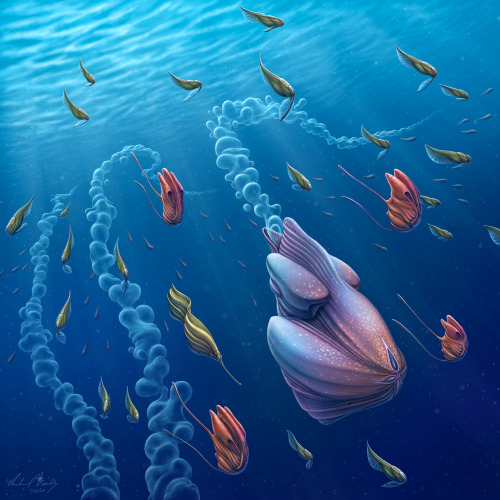
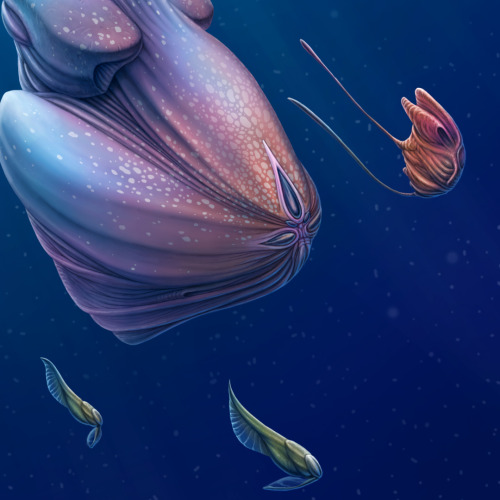
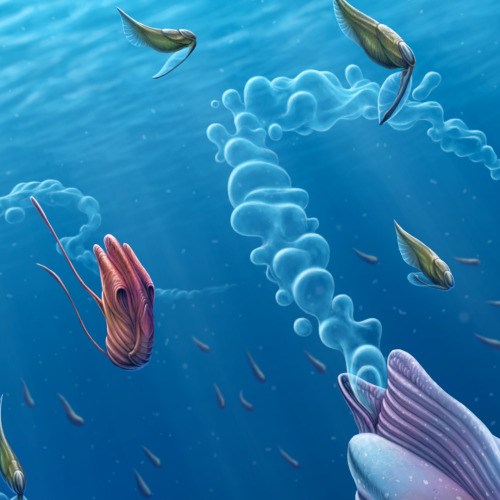
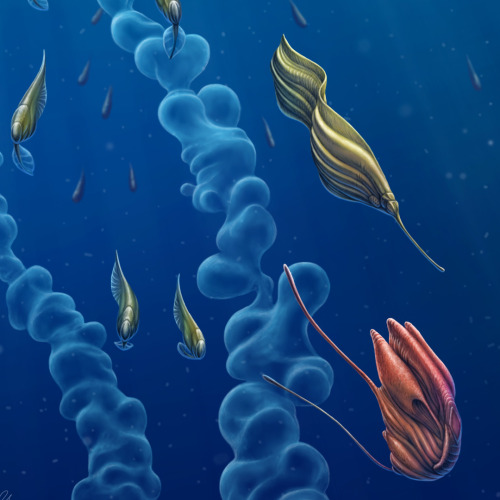
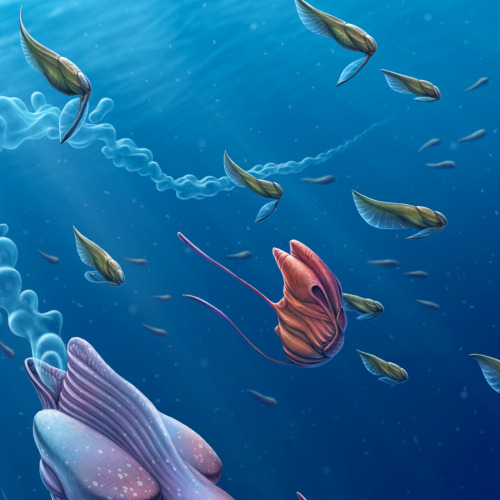
Back to the Depths
An entourage of opportunistic creatures accompanies the deep-sea behemoths during their brief ascent to the surface. Releasing their gelatinous strings of embryos here in the sunlight has a significant benefit - there's far more visibility. The swarm of followers are here in search of a quick meal in the form of the gelatin, which is full of valuable protiens and nutrients. After the feast however, the recipients of this apparent windfall become unwitting hosts for the behemoth's multitudinous offspring, which were embedded in the gel. Adapted to develop inside a wide variety of pelagic creatures, the young grow internally - and sometimes even on the surface of - their hosts until such time as they detach and sink back into the darkness. For most host species, this seems to be a mutually-beneficial symbiosis. At the beginning they receive a large and valuable meal, and usually incur very little detriment due to their temporary parasites. The young behemoths will hide in the dark depths for many years until attaining the size necessary to return to the light and repeat the ancient cycle again.




In my orange phase.





Herders
Out on the plains, a group of herders watches over its flock. At around 15 feet in height, the Magnavindix have flat tops, good for catching the sun’s rays to supplement their energy requirements through photosynthesis. The majority of their sustenance however, comes from the placid, defenseless Iumentus creatures they tend to. Imposing in stature and well armed, they play the role of defender, shepherd, and also matchmaker, bringing a pair of Iumentus together when their biolights signal readiness to breed. Indeed this symbiosis has grown so exclusive that the Magnavindix have evolved specialized appendages that are only useful in carrying the Iumentus. Having no concern for danger, the livestock are free to grow fat and slow as they wander the open plain, grazing on the expanse of the fibrous purple carpet creature that dominates this land. Other species benefit from this arrangement too. The shy Brush-faced Verecundas stay close to the herd as their giant guardians deter nearly all predators that would attempt to approach.
-
 neardeparture liked this · 6 months ago
neardeparture liked this · 6 months ago -
 tundragravedigger reblogged this · 8 months ago
tundragravedigger reblogged this · 8 months ago -
 tundragravedigger liked this · 8 months ago
tundragravedigger liked this · 8 months ago -
 ara6gir liked this · 10 months ago
ara6gir liked this · 10 months ago -
 lamehandle liked this · 10 months ago
lamehandle liked this · 10 months ago -
 idontwannaliveinasociety liked this · 1 year ago
idontwannaliveinasociety liked this · 1 year ago -
 crepuscular-girlthing liked this · 1 year ago
crepuscular-girlthing liked this · 1 year ago -
 wtrotsky-blog liked this · 1 year ago
wtrotsky-blog liked this · 1 year ago -
 theultramangus liked this · 2 years ago
theultramangus liked this · 2 years ago -
 guttersucc reblogged this · 2 years ago
guttersucc reblogged this · 2 years ago -
 spiffyspidr liked this · 2 years ago
spiffyspidr liked this · 2 years ago -
 greatpartyhandscowboy liked this · 2 years ago
greatpartyhandscowboy liked this · 2 years ago -
 jailqueen reblogged this · 2 years ago
jailqueen reblogged this · 2 years ago -
 drhoz liked this · 2 years ago
drhoz liked this · 2 years ago -
 pondmain reblogged this · 2 years ago
pondmain reblogged this · 2 years ago -
 gray-science liked this · 2 years ago
gray-science liked this · 2 years ago -
 gareef reblogged this · 2 years ago
gareef reblogged this · 2 years ago -
 the-explorers-journal liked this · 2 years ago
the-explorers-journal liked this · 2 years ago -
 scientificallyaccuratedragon reblogged this · 2 years ago
scientificallyaccuratedragon reblogged this · 2 years ago -
 walkingmybird liked this · 2 years ago
walkingmybird liked this · 2 years ago -
 opportunistic-old-one liked this · 2 years ago
opportunistic-old-one liked this · 2 years ago -
 skullsulker liked this · 2 years ago
skullsulker liked this · 2 years ago -
 haitiangyaru liked this · 2 years ago
haitiangyaru liked this · 2 years ago -
 the-akashic-records reblogged this · 2 years ago
the-akashic-records reblogged this · 2 years ago -
 shitou456 liked this · 3 years ago
shitou456 liked this · 3 years ago -
 omegaxenonaut liked this · 3 years ago
omegaxenonaut liked this · 3 years ago -
 sinnersinsuits liked this · 3 years ago
sinnersinsuits liked this · 3 years ago -
 hisserdeer liked this · 3 years ago
hisserdeer liked this · 3 years ago -
 theskyrabbit liked this · 3 years ago
theskyrabbit liked this · 3 years ago -
 eshkrigal liked this · 3 years ago
eshkrigal liked this · 3 years ago -
 gninnel liked this · 3 years ago
gninnel liked this · 3 years ago -
 soulinaearthsuit liked this · 3 years ago
soulinaearthsuit liked this · 3 years ago -
 aphid-kirby liked this · 3 years ago
aphid-kirby liked this · 3 years ago -
 jeremy-remy-davis liked this · 3 years ago
jeremy-remy-davis liked this · 3 years ago -
 squirrel-stars liked this · 3 years ago
squirrel-stars liked this · 3 years ago -
 robinsoninspace liked this · 3 years ago
robinsoninspace liked this · 3 years ago -
 cerbercry liked this · 3 years ago
cerbercry liked this · 3 years ago -
 annoyingalchemist liked this · 3 years ago
annoyingalchemist liked this · 3 years ago -
 ferncube liked this · 3 years ago
ferncube liked this · 3 years ago -
 tom-tomorrow reblogged this · 3 years ago
tom-tomorrow reblogged this · 3 years ago -
 ya-boy-husk liked this · 4 years ago
ya-boy-husk liked this · 4 years ago